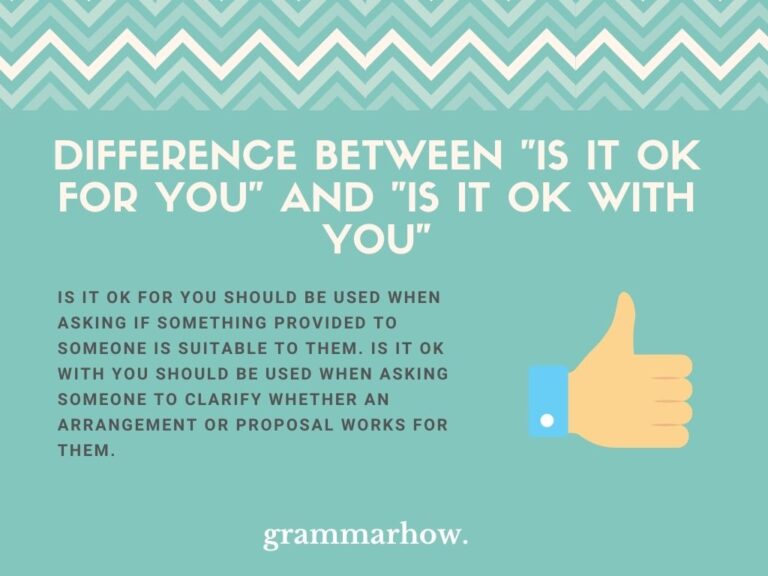In today's fast-paced world, the phrase "Is it OK for you?" often pops up in conversations, whether we're discussing personal choices, making plans, or navigating our relationships. But what does it really mean? This blog post seeks to peel back the layers of this common expression, helping you grasp its significance and how to use it correctly in various situations. By the end of this post, you'll feel more confident in understanding the phrase and embracing its implications in your everyday life.
Defining the Phrase

The phrase "Is it OK for you?" is more than just a simple question; it carries weight in communication. Essentially, it invites the listener to consider their feelings, preferences, or boundaries regarding a particular situation. Let's break it down further:
- Inclusiveness: When you ask someone if something is OK for them, you're acknowledging their perspective. It shows that you value their opinion and want to make sure they are comfortable.
- Empathy: This phrase is a way of expressing empathy. It's a method of reaching out and showing that you care about how others feel.
- Boundaries: It helps establish boundaries. By asking this question, you signal that you’re not assuming what’s appropriate for someone else; rather, you’re open to discussing their limits.
- Flexibility: The phrase implies a willingness to adapt. It suggests that you are ready to find a solution that works for everyone involved.
To illustrate further, let’s consider some examples:
| Scenario | Usage |
|---|---|
| Making Plans | "Is it OK for you if we meet at 6 PM instead of 5?" |
| Proposing Ideas | "Is it OK for you if I suggest a different approach?" |
| Personal Boundaries | "Is it OK for you if I share this information?" |
Understanding this phrase can change how we interact with others, fostering positive communication and deeper connections.
Common Contexts for Usage

Understanding "Is it OK for you?" can vary significantly based on the context in which it’s used. Here are some common scenarios where this phrase often pops up:
- Personal Relationships: In conversations with friends or family, this phrase can be a gentle way to gauge someone’s comfort level with an idea, plan, or suggestion. For example, “Is it OK for you if we go to dinner at 7 PM?” shows consideration for their schedule.
- Work Environment: In professional settings, this phrase may come into play while discussing deadlines or workloads. A colleague may say, “Is it OK for you if I send this report tomorrow?” This helps to maintain a collaborative and respectful workplace.
- Customer Service: Customer service representatives often use this phrase to ensure that they’re meeting the client's needs. For example, “Is it OK for you if I place you on hold for a moment?” reflects a desire to keep the customer informed and comfortable.
- Health and Well-being: When discussing medical treatments or lifestyle changes, practitioners might ask, “Is it OK for you if we try this new medication?” This not only respects the patient’s autonomy but also empowers them in their healthcare choices.
By recognizing these contexts, we can better understand how thoughtful communication plays a vital role in our interactions.
Correct Usage Examples

Now that we've explored some common contexts, let’s dive into specific examples of how to use "Is it OK for you?" correctly:
| Scenario | Example Usage |
|---|---|
| Making Plans | “Is it OK for you if we meet at noon instead of 1 PM?” |
| Negotiating Deadlines | “Is it OK for you to submit the project next Friday instead of this Monday?” |
| Offering Assistance | “Is it OK for you if I help you with those tasks?” |
| Gathering Feedback | “Is it OK for you to share your thoughts on the presentation?” |
In each of these examples, the phrase is used to foster open communication and obtain a clear understanding of someone else's willingness to proceed in a particular way. It’s all about creating a comfortable atmosphere where everyone feels respected and heard!
Common Mistakes to Avoid
When trying to understand whether something is okay, it's essential to navigate this terrain carefully. Here are some common pitfalls people often fall into:
- Assuming Everyone Shares Your Beliefs: Just because something feels okay to you doesn't mean it will feel the same for someone else. Always consider other perspectives.
- Ignoring Boundaries: Respect the boundaries of others. What might be permissible for you may not be acceptable for someone else.
- Overgeneralizing: Avoid making broad statements based on limited experiences. It's important to assess each situation uniquely rather than lumping everything together.
- Neglecting Cultural Differences: Different cultures can have varying views on what is acceptable. Do your research and be mindful of these differences.
- Rushing to Judgment: Take your time to gather all the necessary information before concluding whether something is okay. A hasty decision can lead to misunderstandings.
To minimize these mistakes, engage in open dialogue with others, and practice active listening. Being aware of these pitfalls will help you foster healthier relationships while navigating the nuances of what's acceptable in various contexts.
The Importance of Context
Understanding what is okay isn't just about the action itself; it heavily relies on context. Let's discuss some crucial elements of context that can influence your understanding:
| Element | Description |
|---|---|
| Social Setting | The dynamics of the group you're in can greatly impact whether something is seen as appropriate. |
| Personal Relationships | Your relationship with the individuals involved will shape perceptions and reactions to certain actions. |
| Cultural Norms | Different cultures have varied standards of acceptability. It's always good to be informed about these differences. |
| Timing | The time and place can also affect whether something is okay. What may be acceptable in one situation might not be in another. |
In summary, context can be the difference between something being totally okay or completely unacceptable. Always consider the surrounding factors before determining if something is right for you or the situation at hand. By doing so, you can foster understanding and avoid unnecessary conflicts.
Understanding Is It OK for You and How to Use It Correctly
Understanding whether something is acceptable or appropriate—referred to as "Is It OK for You"—is crucial in various contexts, including personal interactions, professional environments, and social situations. This concept encourages awareness and open communication, promoting a healthy and respectful atmosphere for everyone involved.
To determine if something is "OK," consider the following key aspects:
- Context: Assess the specific situation. What may be acceptable in one scenario may not be in another.
- Boundaries: Recognize your personal and others' boundaries. Are you respecting these boundaries?
- Intent: Evaluate the intent behind actions. Are they constructive or harmful?
- Impact: Understand how your actions affect others. Do they lead to positive or negative feelings?
- Consent: Ensure that all parties involved are comfortable with the situation.
To aid in deciding if something is "OK," you can use the following table as a quick reference:
| Aspect | Questions to Ask |
|---|---|
| Context | Is this the right time and place? |
| Boundaries | Am I following established rules? |
| Intent | What are my motives? |
| Impact | How will this affect others? |
| Consent | Has everyone agreed to this? |
Ultimately, understanding whether something is "OK" requires careful reflection and consideration of various factors. By applying these guidelines, you can navigate situations with greater confidence and respect for those around you.










